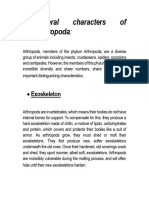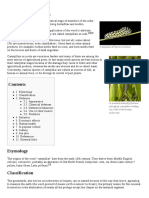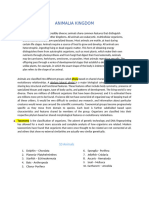Beetles
Beetles
Uploaded by
rockingcommatoesCopyright:
Available Formats
Beetles
Beetles
Uploaded by
rockingcommatoesCopyright
Available Formats
Share this document
Did you find this document useful?
Is this content inappropriate?
Copyright:
Available Formats
Beetles
Beetles
Uploaded by
rockingcommatoesCopyright:
Available Formats
Beetles: The Diverse and Remarkable Insects
Introduction to Beetles
Beetles are the largest group of insects, belonging to the order
Coleoptera, which is derived from the Greek words koleos (sheath) and
pteron (wing), referring to their distinctive hard, protective wing covers.
With over 400,000 species described to date and potentially many more
undiscovered, beetles make up about 40% of all known insects. They are
found in nearly every ecosystem on Earth, from forests to deserts,
freshwater to marine environments. Their incredible diversity, varied
habitats, and ecological roles make them both fascinating and important
in the natural world.
The Biology of Beetles
Anatomy and Physical Features
Exoskeleton and Wings: Beetles have a tough, protective
exoskeleton made of chitin. The front pair of wings, called elytra,
are hardened and serve as protective covers for the delicate hind
wings, which are used for flight. The hind wings are often
membranous and fold beneath the elytra when not in use.
Antennae: Beetles have a wide range of antennae shapes, often
long and segmented. These sensory organs are crucial for detecting
pheromones, navigating, and finding food.
Mouthparts: Most beetles are equipped with chewing mouthparts,
which they use to consume various types of food, from plants to
decaying matter, depending on the species. Some beetles, like the
leaf beetles, are herbivores, while others, like the predatory ground
beetles, are carnivores.
Legs: Beetles typically have three pairs of legs, adapted for various
types of locomotion. Some species, like water beetles, have
modified legs for swimming, while others, like digging beetles,
have legs adapted for burrowing.
Life Cycle of a Beetle
Beetles undergo a complete metamorphosis, meaning they pass through
four distinct stages: egg, larva (often called a grub), pupa, and adult.
This process is similar to that of butterflies, but with notable differences
in the pupal stage.
1. Egg: Beetles begin life as eggs, which are usually laid in or near
their food sources. The eggs are often tiny, and the female beetle
may lay dozens or even hundreds at a time, depending on the
species.
2. Larva (Grub): After hatching, the beetle enters the larval stage.
Larvae vary greatly in shape and size but are often worm-like or
grub-like. During this stage, beetles consume large amounts of
food to fuel their growth. Some larvae are plant-eaters, while
others may feed on fungi or decaying matter.
3. Pupa: After reaching a certain size, the larva enters the pupal
stage. This is a resting and transformative phase, where the beetle
reorganizes its body structure. The pupa is usually encased in a
protective cocoon or chamber.
4. Adult: The final stage is the adult beetle, which emerges from the
pupa. The adult form often has functional wings, though some
beetles (like the firefly) retain reduced wings. Adults typically live
to reproduce, starting the cycle anew.
Beetle Behavior and Ecology
Feeding and Diet
Beetles exhibit a wide range of feeding habits. Some beetles are
herbivores, feeding on leaves, roots, or seeds, while others are
scavengers, consuming decomposing organic matter. There are also
predatory beetles that hunt other insects, and some beetles are parasitic,
living off the tissues of their hosts.
Herbivorous Beetles: Many beetles, such as the Colorado potato
beetle, feed on plants, and some cause significant damage to crops.
Scavenger Beetles: Species like dung beetles (e.g., Scarabaeidae)
feed on dung and are crucial for recycling nutrients in ecosystems.
Dung beetles burrow into the soil, enriching it with organic matter.
Predatory Beetles: Ground beetles are aggressive hunters that
capture and eat other insects. Some of these beetles, such as the
ladybird beetle (ladybug), are considered beneficial because they
help control pest populations.
Communication
Beetles use various methods to communicate. Many beetles release
chemicals called pheromones to attract mates or mark territory. Some
species also use sound or vibrations, created by rubbing parts of their
bodies together (a process called stridulation), to communicate with
other beetles.
Defense Mechanisms
Beetles employ a wide range of defensive strategies to protect
themselves from predators:
Camouflage: Many beetles have bodies that blend in with their
environment. For example, bark beetles look like pieces of bark,
while certain weevils mimic twigs or leaves.
Chemical Defenses: Some beetles, like the bombardier beetle,
have specialized glands that produce toxic chemicals, which they
can spray at predators as a defense mechanism.
Armor: The hard exoskeleton of many beetles offers protection
against predators. Some species even have spines or thick armor
that make them difficult to attack.
Common Beetle Species
1. Ladybird Beetle (Coccinellidae family)
Ladybird beetles, often called ladybugs, are small, round, brightly
colored beetles with red, orange, or yellow bodies adorned with black
spots. They are beneficial predators, especially in gardens, as they feed
on aphids and other pests.
2. Dung Beetle (Scarabaeidae family)
Dung beetles are well-known for their role in recycling nutrients. They
collect animal dung, roll it into balls, and bury it. Some species even use
dung as food for their larvae.
3. Japanese Beetle (Popillia japonica)
A notorious pest in many parts of the world, the Japanese beetle is a
shiny, metallic green beetle with coppery-brown wings. It feeds on a
wide variety of plants, including roses and grapes, causing significant
damage to crops.
4. Click Beetle (Elateridae family)
Click beetles are famous for their ability to "click" or snap their bodies
to flip into the air when they are threatened. This behavior helps them
escape predators or flip themselves over if they are on their backs.
5. Stag Beetle (Lucanidae family)
Stag beetles are large, impressive beetles with large, antler-like
mandibles. These mandibles are used by males in combat with other
males for territory or mates. They are commonly found in wooded areas
and are known for their striking appearance.
Beetles and Humans
Ecological Importance
Beetles play vital roles in ecosystems. As pollinators, decomposers, and
predators, they help maintain the balance of nature. Dung beetles, for
example, help break down animal waste and recycle nutrients into the
soil, while predatory beetles control pest populations, reducing the need
for chemical pesticides.
Economic Impact
While many beetles are beneficial, some species can cause significant
damage to crops, wood, and stored products. The Colorado potato
beetle, for example, is a major pest of potato crops, and wood-boring
beetles can damage trees and timber. Efforts to control these pests
through natural predators, biological controls, or pesticides are ongoing.
Cultural Significance
Beetles also have cultural significance in many societies. The scarab
beetle, for example, was a symbol of protection and rebirth in ancient
Egypt, often used in jewelry and amulets.
Conservation and Threats
While many beetles thrive in the wild, habitat destruction, pollution, and
climate change are putting pressure on their populations. Some species,
like the endangered emerald ash borer, are spreading due to human
activities and threatening ecosystems. Conservation efforts focus on
protecting habitats, reducing pesticide use, and studying beetle
populations to ensure their survival.
Conclusion
Beetles are some of the most fascinating and diverse creatures on Earth.
From their unique anatomy and life cycle to their essential ecological
roles, beetles contribute significantly to the health of ecosystems.
Whether as pollinators, decomposers, or pests, they shape the world
around us in ways we often take for granted. By understanding and
appreciating beetles, we can better protect them and the environment
they help sustain.
You might also like
- Beetles are a group of insects belonging to the order Coleoptera, the largest order in the animal kingdom, with over 400,000 described species and many more yet to be discovered (3)No ratings yetBeetles are a group of insects belonging to the order Coleoptera, the largest order in the animal kingdom, with over 400,000 described species and many more yet to be discovered (3)2 pages
- Caterpillar: Caterpillars Are The Larval Form of Members of The Order Lepidoptera (The Insect OrderNo ratings yetCaterpillar: Caterpillars Are The Larval Form of Members of The Order Lepidoptera (The Insect Order8 pages
- The Five-Kingdom System of ClassificationNo ratings yetThe Five-Kingdom System of Classification9 pages
- Kingdoms Notes and Brochure Activity PDFNo ratings yetKingdoms Notes and Brochure Activity PDF8 pages
- MCP 201 - The Kingdom Protista, Classification and Nomenclature of BacteriaNo ratings yetMCP 201 - The Kingdom Protista, Classification and Nomenclature of Bacteria35 pages
- WRITTEN-REPORT-FOR-BIOLOGY-INVERTEBRATESNo ratings yetWRITTEN-REPORT-FOR-BIOLOGY-INVERTEBRATES17 pages
- Beige Vintage Insects Nature PresentationNo ratings yetBeige Vintage Insects Nature Presentation47 pages
- Beetle: Beetle Beetles Are A Group of Insects That Form The Order Coleoptera, in TheNo ratings yetBeetle: Beetle Beetles Are A Group of Insects That Form The Order Coleoptera, in The38 pages
- Characteristic and Role of Ants - Muhammad Iqbal FauzanNo ratings yetCharacteristic and Role of Ants - Muhammad Iqbal Fauzan2 pages
- ENT 321 beneficial insects part I_from999No ratings yetENT 321 beneficial insects part I_from9997 pages
- (Biol 12) Grade 9 - Unit 5 Notes and MCQ (2016)No ratings yet(Biol 12) Grade 9 - Unit 5 Notes and MCQ (2016)18 pages
- Rice Whorl Maggot (Hydrellia (Diptera: Ephydridae: Philippina Ferino)No ratings yetRice Whorl Maggot (Hydrellia (Diptera: Ephydridae: Philippina Ferino)22 pages
- Aphid, (Family Aphididae), Also Called Plant Louse, Greenfly, or Ant Cow, Any of A Group of SapNo ratings yetAphid, (Family Aphididae), Also Called Plant Louse, Greenfly, or Ant Cow, Any of A Group of Sap11 pages
- The Head The Antennae - Can Be Found On Top of TheNo ratings yetThe Head The Antennae - Can Be Found On Top of The4 pages
- Industrial Intomology and Mushrooms CultivationNo ratings yetIndustrial Intomology and Mushrooms Cultivation53 pages
- Figure 2. Class Arachnida: (A) Spider, (B) MiteNo ratings yetFigure 2. Class Arachnida: (A) Spider, (B) Mite7 pages
- Social Organization in Honey Bees PPT - Google SeNo ratings yetSocial Organization in Honey Bees PPT - Google Se1 page
- Pesticide Toxicity To Non Target Organisms Pesticide Toxicity To Parasitoids Exposure, Toxicity and Risk Assessment MethNo ratings yetPesticide Toxicity To Non Target Organisms Pesticide Toxicity To Parasitoids Exposure, Toxicity and Risk Assessment Meth54 pages
- The Natural History of Bees - G Bazin (1744)100% (2)The Natural History of Bees - G Bazin (1744)520 pages
- 013 DO YOU WONDER WHY BUGS ARE GOOD Free Childrens Book by Monkey PenNo ratings yet013 DO YOU WONDER WHY BUGS ARE GOOD Free Childrens Book by Monkey Pen18 pages
- 2 Broflanilide Interactive Guide 1.15.20No ratings yet2 Broflanilide Interactive Guide 1.15.2020 pages
- Beetles are a group of insects belonging to the order Coleoptera, the largest order in the animal kingdom, with over 400,000 described species and many more yet to be discovered (3)Beetles are a group of insects belonging to the order Coleoptera, the largest order in the animal kingdom, with over 400,000 described species and many more yet to be discovered (3)
- Caterpillar: Caterpillars Are The Larval Form of Members of The Order Lepidoptera (The Insect OrderCaterpillar: Caterpillars Are The Larval Form of Members of The Order Lepidoptera (The Insect Order
- Insects: Discover the Science and Secrets Behind the World of InsectsFrom EverandInsects: Discover the Science and Secrets Behind the World of Insects
- MCP 201 - The Kingdom Protista, Classification and Nomenclature of BacteriaMCP 201 - The Kingdom Protista, Classification and Nomenclature of Bacteria
- Beetle: Beetle Beetles Are A Group of Insects That Form The Order Coleoptera, in TheBeetle: Beetle Beetles Are A Group of Insects That Form The Order Coleoptera, in The
- Characteristic and Role of Ants - Muhammad Iqbal FauzanCharacteristic and Role of Ants - Muhammad Iqbal Fauzan
- Rice Whorl Maggot (Hydrellia (Diptera: Ephydridae: Philippina Ferino)Rice Whorl Maggot (Hydrellia (Diptera: Ephydridae: Philippina Ferino)
- Aphid, (Family Aphididae), Also Called Plant Louse, Greenfly, or Ant Cow, Any of A Group of SapAphid, (Family Aphididae), Also Called Plant Louse, Greenfly, or Ant Cow, Any of A Group of Sap
- The Head The Antennae - Can Be Found On Top of TheThe Head The Antennae - Can Be Found On Top of The
- Pesticide Toxicity To Non Target Organisms Pesticide Toxicity To Parasitoids Exposure, Toxicity and Risk Assessment MethPesticide Toxicity To Non Target Organisms Pesticide Toxicity To Parasitoids Exposure, Toxicity and Risk Assessment Meth
- 013 DO YOU WONDER WHY BUGS ARE GOOD Free Childrens Book by Monkey Pen013 DO YOU WONDER WHY BUGS ARE GOOD Free Childrens Book by Monkey Pen

























































































